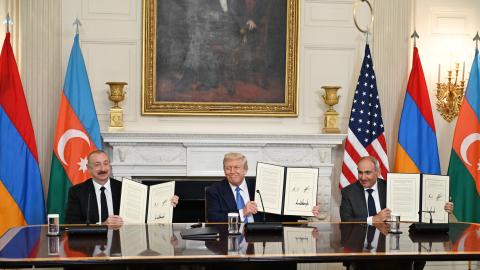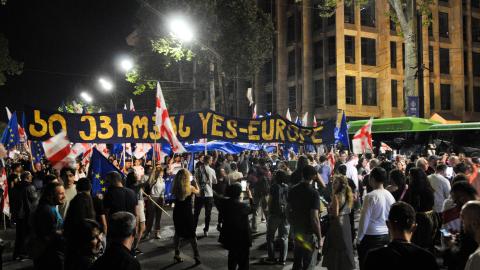In recent days, hundreds of thousands of Georgians have taken to the streets of their country’s capital, Tbilisi, to protest a controversial draft law being debated in the Georgian Parliament. The government, led by the Georgian Dream party, calls the draft law the “Transparency of Foreign Influence” bill. Opponents refer to it as the “Russian law” because it mirrors a Kremlin law designed to silence, stifle, and shut down political opposition. In the latest escalation overnight, Georgian police used water cannon, tear gas, and rubber bullets to break up continuing protests against the law.
If passed, the law would require all nongovernmental organizations to declare if they receive a certain amount of their funding from abroad. Opponents of the bill argue that these measures will weaken civil society and threaten freedom of speech. If the experience in Russia is anything to go by, their concerns are well founded.
Last year, the Georgian government introduced similar legislation, only to withdraw the bill from Parliament after several days of major demonstrations. The new bill is basically identical to last year’s draft. The difference this time is that the demonstrations—supported by opposition politicians and civil society groups—are larger and the public outcry greater than before. Georgian, Ukrainian, and European Union flags are commonplace among the crowds, where young people are heavily represented. The bill already passed its first reading in Parliament. This week, the draft law passed its second reading, and Georgian Dream bused people into Tbilisi from around the country for a rally in favor of the bill. In a fiery speech, Georgian Dream founder Bidzina Ivanishvili promised “punishment” to the main opposition party and civil society groups speaking out against the government.
The third and final reading of the bill is expected to take place around May 17—another expected flash point on Tbilisi’s streets. After the bill’s likely passage, it will be sent to Georgian President Salome Zourabichvili, who has promised to veto it. Georgian Dream can then use its majority in Parliament to override the veto and bring the bill into law.
Georgia’s Western partners are ringing the alarms. Today, EU foreign policy chief Josep Borrell condemned the latest violence against protesters. Earlier, European Council President Charles Michel stated that the draft law “will bring Georgia further away from the EU.” A U.S. State Department spokesperson said: “We are gravely disappointed by the Georgian parliament’s decision to advance Kremlin-inspired ‘foreign influence’ legislation.” Javier Colomina, NATO’s special representative for the Caucasus and Central Asia, posted on social media: “This draft is a step backwards & does not further [Georgia’s] Euro-Atlantic integration.” Considering that almost 80 percent of Georgians see their future in the EU, the mass demonstrations against the draft law are not surprising.
Meanwhile, there has been nothing but support for the Georgian government from Moscow. Outspoken Russian philosopher and Kremlin insider Alexander Dugin declared that “Georgia is on the right track” with the reintroduction of the law. Kremlin spokesperson Dmitry Peskov blamed the West for provoking “anti-Russian sentiments” among Georgians. Russian Foreign Minister Sergey Lavrov, too, has publicly defended Georgia’s draft law.
After entering office in 2012, Georgian Dream led a coalition that proved to be a good partner for the West. Even though there were always elements inside Georgian Dream whose sympathies lay with Moscow, they were kept marginalized by the coalition’s Euro-Atlanticist mainstream. Over the years, however, the pro-Russian elements of Georgian Dream worked their way to the top while pushing Western-oriented members out of government.
The result is a Georgian Dream that looks nothing like it did in 2012. The party now pursues policies that unfairly marginalize the political opposition. While the government’s official policy remains for Georgia to join the EU and NATO, little is being done to achieve this goal. After the Russian invasion of Ukraine, the Georgian government questioned Western sanctions against Moscow, refused to join, and instead increased trade with Russia. Senior Georgian Dream officials have publicly ridiculed successive U.S. ambassadors. Georgians fighting for Ukraine as volunteers are scorned by the government.
You can bet that the Kremlin is closely watching. The moment it appears that Georgian Dream is losing its grip on power, there is a high likelihood that Moscow will intervene—especially if the government’s downfall comes as a result of mass demonstrations, which, in the Kremlin’s obsessive worldview, would be a “color revolution” conspiratorially engineered by the West. And if you believe that a Russian invasion scenario is unrealistic, you have not been paying attention in recent years. Russian advisors and security forces helped prop up Belarusian dictator Aleksandr Lukashenko after mass protests following stolen elections in August 2020. In January 2022, Russia led a military intervention in Kazakhstan to restore order after several days of political violence. And Russia’s initial invasion of Ukraine in 2014 followed the Maidan Revolution that deposed a Russia-friendly president. There is no reason to think that Russia would not do any of these things in Georgia.
Russia already occupies 20 percent of Georgia’s territory, following its 2008 invasion. Another Russian incursion—triggered by an impending downfall of Georgia’s Kremlin-friendly government—could take a number of forms. Since Georgian Dream likes to portray itself to the Georgian people as the only thing standing between them and another Russian invasion, Moscow might calculate that a military provocation from Russian-occupied South Ossetia or Abkhazia, if it is dramatic enough, could frighten the Georgian public to fall back in line with its government.
Another scenario involves the hundreds of thousands of Russians who have moved to Georgia in recent years. Even if many of them did so to escape military service and economic hardship in Russia, it is impossible to know the extent to which the Kremlin’s security and intelligence services have infiltrated this diaspora. Moscow’s track record shows that it could intervene to “protect” the Russian minority, especially if there have been accusations of mistreatment of Russian citizens.
In the most extreme scenario, Russia could attempt an invasion to bring Georgia fully into the Kremlin’s orbit. This may be a low-probability scenario given Russia’s challenges in Ukraine, not least its vast losses of manpower and equipment. But just as Russia’s full-on invasion of Ukraine in 2022 surprised even the most seasoned experts, nothing can be ruled out. Although there are few public details, it is known that Russia has been militarizing the occupied regions of Georgia in recent years, even if some Russian troops based in Abkhazia or South Ossetia have been sent to Ukraine. Around 2,000 Russian troops are now leaving Azerbaijan-controlled Nagorno-Karabakh, and it’s anyone’s guess where these soldiers will be going next.
Of course, a large number of Georgians would resist a Russian intervention. The Georgian armed forces are better trained and equipped than they were when Russia last invaded in 2008, and there are more soldiers with combat experience, mainly from Afghanistan. There are also thousands of Georgians fighting as volunteers in Ukraine who would be itching to defend their motherland.
Another Russian move into Georgia could have implications for U.S. interests in the region. For example, controlling Georgia would give Moscow access to more Black Sea coastline at a time when its navy is being pushed out of the western Black Sea, including the ports in occupied Crimea, by successful Ukrainian drone and missile strikes. Occupying even a small additional slice of Georgia would also give Russia control of every major oil and gas pipeline that connects the vast energy resources of Azerbaijan and Kazakhstan to Europe; at their closest points, both Georgia’s main east-west highway and several energy pipelines almost directly abut Russian-occupied South Ossetia. Any disruption would create significant energy problems for Europe and by extension NATO and the United States.
Finally, Russian control of Georgia would establish a much-desired land bridge with Moscow’s ally Armenia. This, in turn, would create a direct land and air corridor between Russia and Iran at a time of deepening military cooperation between the two countries. Looking at a map, such a corridor between Russia and Iran would allow Moscow to control much of the east-west transit on the Eurasian landmass. Crucially for Russian President Vladimir Putin, a lightening intervention into Georgia could give him a much-needed geopolitical victory after more than two years of being mired in Ukraine.
In a park overlooking the banks of the Kura River in Tbilisi, there is a bronze statue of former U.S. President Ronald Reagan. It is perhaps no coincidence that the statue shows him facing north—toward Russia. The statue could be seen as a reminder for Georgians of how far they have come since the oppressive days of Soviet rule. Before Russia is tempted to intervene, Georgian Dream should stop the escalating confrontation on Tbilisi’s streets and withdraw the bill. This is the message that Western capitals need to be urgently sending.


















